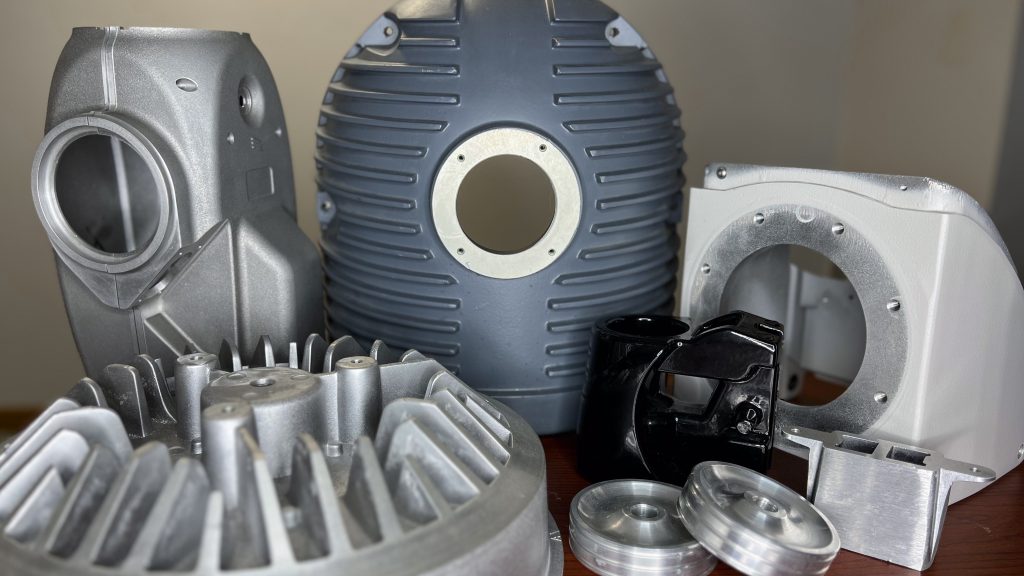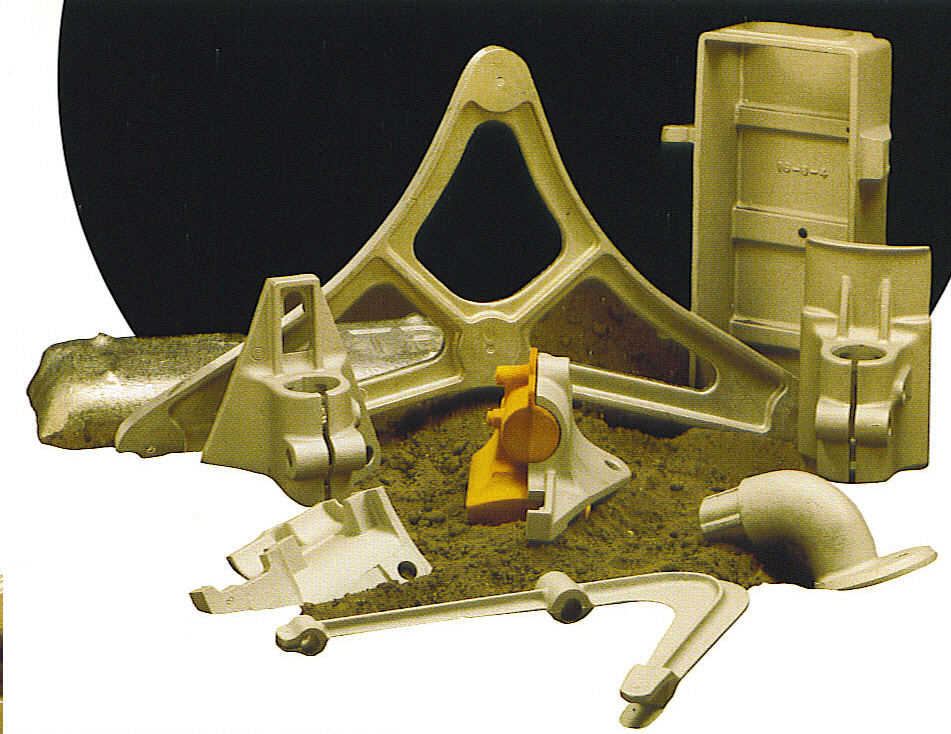Revealing the Conveniences and Practical Utilizes of Light Weight Aluminum Castings in Today's Market
Light weight aluminum castings have become significantly pertinent in various sectors as a result of their unique attributes. Their light-weight nature and resistance to deterioration make them suitable for demanding applications. Furthermore, the premium strength-to-weight ratio supplies significant benefits in style and manufacturing. As markets proceed to discover their possibility, the complete extent of light weight aluminum spreadings' applications and advantages remains to be totally uncovered. What exists in advance for this versatile product?
The Lightweight Benefit of Light Weight Aluminum Castings
Although lots of materials are utilized in production, light weight aluminum spreadings attract attention primarily as a result of their lightweight buildings. This characteristic makes aluminum spreadings an attractive selection for various sectors, specifically in aerospace and vehicle applications, where weight reduction is crucial for improving fuel efficiency and performance. The lightweight nature of aluminum allows makers to produce elements that are easier to install and manage, inevitably decreasing labor prices.
Moreover, the capability to generate complicated shapes without substantial weight penalties makes it possible for developers to introduce while preserving architectural honesty. Light weight aluminum spreadings can effectively change larger products, resulting in substantial financial savings in delivery and functional expenses. Their lightweight advantage also adds to improved item long life, as lighter elements usually result in lowered deterioration on equipment. In general, the lightweight buildings of aluminum spreadings supply suppliers with an one-upmanship, promoting developments in item style and performance across various markets.

Outstanding Corrosion Resistance
Aluminum castings have a natural resistance to oxidation, which substantially improves their longevity in numerous atmospheres. This integral home not only contributes to their longevity however also lines up with the light-weight benefit that aluminum offers. Consequently, aluminum castings are progressively acknowledged for their remarkable corrosion resistance in countless applications.

Normally Immune to Oxidation
One of the standout characteristics of light weight aluminum spreadings is their phenomenal corrosion resistance, which stems from an all-natural oxidation procedure. When revealed to air, aluminum reacts to develop a thin, protective layer of light weight aluminum oxide. This layer functions as a barrier versus further oxidation and secures the underlying metal from harsh elements such as wetness and salts. Unlike other metals, this oxide layer is self-repairing; if damaged, it swiftly reforms when revealed to air. This one-of-a-kind residential or commercial property boosts the long life of light weight aluminum spreadings in numerous atmospheres, making them optimal for applications in sectors such as aerospace, vehicle, and marine. The natural resistance to oxidation considerably lowers maintenance expenses and boosts the reliability of aluminum castings in requiring conditions.
Light-weight Sturdiness Advantage
The light-weight nature of aluminum castings contributes considerably to their toughness, making them a beneficial selection in various sectors. This remarkable toughness is mainly associated to aluminum's natural resistance to deterioration, which is enhanced better through anodizing and other surface therapies. Unlike several metals, aluminum does not corrosion; rather, it develops a safety oxide layer that guards it from ecological damage. This home is particularly valuable in industries such as vehicle and aerospace, where weight reduction is critical without compromising toughness. Furthermore, the durability of aluminum spreadings lessens maintenance prices and replacements, giving financial advantages with time. As a result, their light-weight resilience and rust resistance position aluminum castings as a premium product for modern-day manufacturing applications.
Superior Strength-to-Weight Ratio
An amazing attribute of aluminum castings is their remarkable strength-to-weight proportion, that makes them very preferable in various applications. This inherent property permits light weight aluminum spreadings to withstand considerable stress while staying light-weight, an essential aspect in sectors such as aerospace, automotive, and production. Designers often prefer aluminum spreadings for components that need both toughness and lowered weight, improving fuel effectiveness and performance.
The high strength-to-weight ratio additionally facilitates the design of elaborate shapes and structures, making aluminum castings functional for facility applications. In addition, the ability to maintain architectural honesty under tough problems assurances longevity and integrity in products, from airplane structures to automobile parts. This advantage adds to the expanding pattern of utilizing light weight aluminum spreadings in innovative styles, inevitably causing improved functionality and effectiveness throughout varied fields. The superior strength-to-weight proportion of aluminum spreadings positions them as a crucial material in modern design and production.
Cost-Effectiveness in Production
Cost-effectiveness in light weight aluminum casting manufacturing is largely accomplished with reduced material waste and efficient manufacturing processes. By optimizing styles and using advanced techniques, suppliers can minimize excess product use while preserving high quality criteria. This strategy not just lowers manufacturing costs yet also adds to extra sustainable methods within the industry.
Decreased Product Waste
Lowering material waste in light weight aluminum spreading procedures significantly boosts production performance. By enhancing the layout and production techniques, companies can lessen excess scrap and improve source usage. This decrease in waste not only lowers product costs yet also contributes to a much more lasting production design. The capacity to recycle light weight aluminum additional assistances cost-effectiveness, permitting manufacturers to redeem and recycle products without endangering top quality. As the sector progressively concentrates on sustainability, reduced product waste aligns with environmental goals while concurrently increasing earnings. Inevitably, effective usage of basic materials enhances the affordable position of businesses in the marketplace, making light weight aluminum castings a desirable choice in numerous applications. The tactical strategy to reducing waste reflects a commitment to both ecological and financial duty.
Reliable Production Processes
While traditional manufacturing processes can incur significant costs, aluminum casting offers a much more effective choice that improves total production earnings. This approach reduces material waste and permits exact control over the manufacturing process, bring about lowered labor and operational prices. The capacity to create complicated shapes with less steps additionally improves manufacturing, adding to much shorter lead times. In addition, aluminum's lightweight nature and exceptional thermal conductivity permit energy financial savings throughout manufacturing and in the final application. By making use of modern casting innovations, manufacturers can achieve greater throughput without giving up top quality. Aluminum spreading stands out as an economical service, making it an eye-catching option for companies intending to maximize their production processes in today's competitive market.
Adaptability Across Industries
Aluminum castings demonstrate amazing adaptability across different industries, as they can be Get More Information customized to fulfill particular needs and applications. In the automotive industry, light weight aluminum castings are used in engine blocks, transmission real estates, and wheels, offering light-weight yet sturdy services that enhance gas efficiency. The aerospace market additionally profits from aluminum castings, utilizing them in structural elements and engine components because of their strength-to-weight ratio.
In the customer goods market, makers use light weight aluminum spreadings for products ranging from cooking equipment to furniture, supplying both aesthetic appeal and capability. The electronic devices sector uses light weight aluminum castings for real estates and warmth sinks, making sure reliable thermal administration. In addition, the construction sector leverages light weight aluminum castings for architectural parts and architectural components, boosting resilience and design versatility. This wide applicability highlights aluminum castings as a crucial resource, fulfilling the diverse needs of various markets while preserving high performance and reliability.
Sustainability and Environmental Influence
As sectors increasingly prioritize sustainable practices, aluminum spreadings emerge as an environmentally friendly option due to their recyclability and reduced environmental footprint. Aluminum is one of the most recycled products worldwide, with the capacity to be repurposed multiple times without destruction of high quality. This characteristic significantly reduces the demand for raw products and energy consumption connected with main aluminum manufacturing, which is energy-intensive.
Furthermore, light weight aluminum spreadings add to light-weight styles, causing sustain efficiency in transport applications such as vehicle and aerospace markets. Their durability and resistance to corrosion expand product lifespans, further lessening waste and source usage in time. Lots of producers are embracing accountable sourcing and environmentally friendly production techniques, enhancing the sustainability of aluminum casting processes. Generally, light weight aluminum castings stand for a functional option for organizations intending to reduce their ecological impact while achieving efficiency and performance.
Developments in Aluminum Spreading Technologies
Current innovations in light weight aluminum casting innovations have greatly enhanced the efficiency and top quality of manufacturing procedures. Innovations such as 3D printing and progressed mold-making strategies have made it possible for manufacturers to produce intricate designs with minimized product waste. This change not just boosts the precision of cast elements however also shortens lead times, permitting fast prototyping and faster market access.
Moreover, the incorporation of innovative computer simulations aids in anticipating potential problems throughout spreading, leading to higher-quality results (Aluminum Castings). Using light-weight alloys has actually likewise contributed to the advancement of stronger, a lot more sturdy products, dealing with markets varying from vehicle to aerospace
Additionally, automated casting processes have emerged, lessening human error and enhancing production rate. Collectively, these innovations are transforming he has a good point the light weight aluminum casting landscape, driving better competition and sustainability in manufacturing. As markets continue to develop, these technologies will play a vital function in meeting future needs for efficiency and top quality.
Regularly Asked Questions
How Do Light Weight Aluminum Castings Contrast to Other Steels in Regards To Thermal Conductivity?
Light weight aluminum castings exhibit remarkable thermal conductivity contrasted to lots of steels, such as steel and iron - Metal Castings. Their lightweight nature and reliable warmth distribution make them perfect for applications requiring effective thermal management in numerous industries
What Are the Common Defects Found in Light Weight Aluminum Castings?
Usual flaws in aluminum castings consist of porosity, shrinkage, inclusions, and surface abnormalities. These problems frequently emerge from improper cooling rates, insufficient mold layout, or contaminations, impacting the total high quality and performance of the final item.
Can Light Weight Aluminum Castings Be Recycled, and Just how?
Aluminum spreadings can be recycled effectively. The process includes accumulating, melting, and changing the light weight aluminum, which decreases waste and saves sources. This recycling adds to sustainability while maintaining the material's residential properties for future use.
What Are the Typical Lead Times for Light Weight Aluminum Casting Manufacturing?
Typically, lead times for light weight aluminum casting production array from 2 to six weeks, depending on variables such as complexity, tooling requirements, and manufacturing volume. Effectiveness can boost with established vendor partnerships and optimized production procedures.
How Does the Surface End Up Affect Light Weight Aluminum Casting Efficiency?
The surface area finish noticeably influences aluminum casting performance by influencing deterioration resistance, visual high quality, and rubbing features. A smoother surface improves sturdiness and functionality, while a rougher appearance can improve attachment for subsequent coverings or therapies.
Lots of products are used in production, aluminum castings stand out largely due you can try here to their lightweight homes. When revealed to air, aluminum responds to develop a slim, protective layer of aluminum oxide. Cost-effectiveness in aluminum casting production is mainly accomplished with reduced product waste and efficient production procedures. Reducing material waste in light weight aluminum casting procedures significantly enhances manufacturing efficiency. Ultimately, efficient usage of raw materials strengthens the affordable placement of services in the market, making light weight aluminum castings a beneficial alternative in different applications.